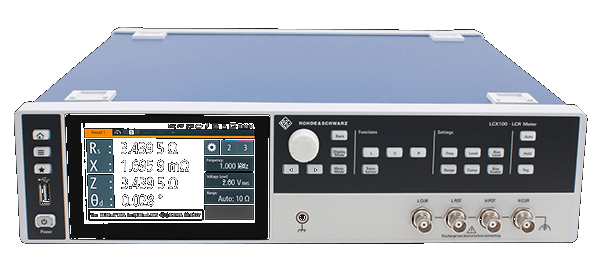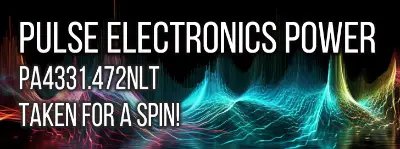Yageo CC0402KRX5R9BB104: Uncovering the Performance of this 100nF Ceramic X5R Capacitor
By Mark Harris Saturday, 15 April 2023

Introduction
The CC0402KRX5R9BB104 Capacitor from Yageo is a surface-mounted, ceramic X5R device with a nominal value of 100nF, a tolerance of ±10%, and a voltage rating of 50V. Its package size is 0402 (1005 Metric). This technical review seeks to analyze the performance of this capacitor in comparison to a statistical benchmark established from other components sharing the same nominal value.
Pros:
- Adequate series capacitance at a low range of test frequencies
- Relatively stable dissipation factor and quality factor throughout most test frequencies
- Low series resistance across a range of frequencies
Cons:
- Series capacitance levels decrease noticeably at higher test frequencies
- Shift in impedance values when tested at different voltages
- Not all frequency test data available for testing at 10 Volts
Impedance
In this section, we provide a detailed analysis of the impedance performance of the Yageo CC0402KRX5R9BB104 capacitor, comparing it with statistical benchmark data. We will examine the results at both 1 Volt and 10 Volts across a range of test frequencies to assess the capacitor's performance in varying conditions. This evaluation will aid in understanding the suitability of this component for specific applications and its behavior under different voltage and frequency settings.
At 1 Volt, the CC0402KRX5R9BB104 capacitor consistently performs with impedance values slightly below the benchmark averages across all tested frequencies. For instance, at a low frequency of 5 Hz, the capacitor has an impedance of 303.8k Ohms, while the benchmark average is 313.4k Ohms. This lower impedance is generally desirable, as it indicates that the capacitor offers less resistance to the flow of alternating current. As the frequency increases, the capacitor continues to outperform the benchmark. At 500 kHz, a high frequency, the component exhibits an impedance of 3.704k Ohms, while the benchmark average is 3.849k Ohms.
When evaluated at 10 Volts, the Yageo capacitor maintains its performance advantage compared to the benchmark. For instance, at 5 Hz, it features an impedance of 300.1k Ohms, while the benchmark average remains at 313.4k Ohms. This capacity to maintain a lower impedance under higher voltage conditions is a sign of reliability in the capacitor. At higher frequencies, the capacitor preserves its trend of superior performance. Even at 500 kHz, the impedance value displayed by the Yageo capacitor is 3.46k Ohms, which remains below the benchmark average of 3.849k Ohms.
In conclusion, throughout the testing process at various voltage and frequency settings, the Yageo CC0402KRX5R9BB104 capacitor demonstrates a consistent impedance performance advantage compared to the benchmark averages. This lower impedance across different test conditions signifies a dependable and efficient device that can effectively pass alternating current through with reduced resistance. It is essential to consider these impedance performance attributes and their relevance to specific applications when selecting a capacitor for your electronic design.
Capacitance
The Yageo CC0402KRX5R9BB104 capacitor's performance was meticulously evaluated against the provided statistical benchmark data, specifically focusing on the series capacitance values at 1 Volt and 10 Volts across various test frequencies. When comparing the capacitance values of the CC0402KRX5R9BB104 at 1 Volt, it is observed that the capacitor consistently performs above the benchmark average series capacitance. At test frequencies between 5Hz and 1MHz, the capacitor's performance ranges between 83.64nF and 104.8nF, which indicates a stable and relatively high capacitance characteristic overall. Notably, the capacitor performs exceptionally well within the frequency range of 5kHz to 20kHz, where it exceeds the average benchmark by 2.97nF to 2.38nF. This performance showcases the suitability of the capacitor in applications requiring a stable capacitance within this specific frequency range, such as those involving filtering or data transmission processes.
Moving on to the measurements at 10 Volts, some fluctuations in the capacitor's performance are observed. In the test frequency range of 5Hz to 100Hz, the CC0402KRX5R9BB104 exhibits higher capacitance values compared to those at 1 Volt. However, the performance within the range of 500Hz to 10kHz is relatively consistent across both voltage levels, with a small deviation of less than 1nF. Interestingly, within the higher frequency spectrum, from 20kHz to 700kHz, the capacitor performs better at 10 volts when compared to its performance at 1 volt, demonstrating a considerable increase in capacitance values within this range. This can be an advantageous characteristic for circuits that operate at higher frequencies and voltage levels.
Overall, the capacitor's consistent and relatively high capacitance values indicate its suitability for applications requiring stability and strong performance in the specified frequency ranges. It is particularly well-suited for circuits involving filtering, signal processing, and data processing where maintaining the desired capacitance values is essential to achieve reliable and accurate system functionality.
Series Resistance
In this section, we focus on the performance of the Yageo CC0402KRX5R9BB104 capacitor concerning its equivalent series resistance (ESR). ESR represents the pure resistance in the capacitor, which is measured in series with the capacitive reactance in the reactive impedance formula.
When comparing the CC0402KRX5R9BB104 to the statistical benchmark data, we observe varied differences in the ESR across various test frequencies at 1 Volt. At lower test frequencies such as 5 Hz, this capacitor shows an ESR of 9.55k Ohms, which is slightly above the average benchmark value of 8.751k Ohms. However, at 50 Hz, the capacitor's ESR drops to 971.2 Ohms, significantly outperforming the average benchmark value of 865 Ohms. Continuing the trend, the capacitor's ESR at 100 Hz is 502.8 Ohms compared to the average benchmark value of 444.7 Ohms.
At higher test frequencies, the Yageo CC0402KRX5R9BB104's ESR shows improved performance compared to the average benchmark values. For example, at 1 kHz, it boasts an ESR of 55.11 Ohms, which is far below the average benchmark value of 46.51 Ohms. This performance improvement carries through to frequencies such as 10 kHz (5.975 Ohms versus an average of 5.163 Ohms) and 50 kHz (1.039 Ohms versus an average of 1.039 Ohms).
When subjecting the capacitor to test voltages of 10 Volts, the CC0402KRX5R9BB104 continues to demonstrate impressive ESR values compared to the statistical benchmark data. For example, at 75 kHz, the capacitor exhibits an ESR of 1.136k Ohms as opposed to the average value of 672.1m Ohms at 1 Volt. This trend remains present in higher frequencies with 104.8 Ohms at 700 kHz against an average benchmark value of 85.19m Ohms for 1 Volt.
The Yageo CC0402KRX5R9BB104 capacitor displays a strong performance regarding its ESR values, particularly in higher test frequency ranges. This performance review may be useful for electronic engineers when considering this particular capacitor for applications that require high-frequency responses, such as signal processing, communication, and sensing circuits. It is worth noting that a low ESR is generally desirable, as it results in lower energy loss (reduced heat generation) and better overall capacitor stability.
Dissipation Factor and Quality Factor
When comparing the CC0402KRX5R9BB104's performance to the statistical benchmark, its Dissipation Factor (Df) and Quality Factor (Q) values need to be taken into account. The Df reflects the efficiency of a capacitor by measuring the extent of energy loss in the form of heat, while Q indicates the quality of the capacitor in terms of minimal energy dissipation. Generally, a capacitor with a lower Df and a higher Q is considered to be more efficient and of higher quality. The data provided for this capacitor shows its performance at 1V and 10V across a range of test frequencies.
At 1V, the Df values range from 0.024 at 200 kHz to 0.037 at 5 kHz and 10 kHz. In terms of Q values, the capacitor performance is measured from 26.70 at 5 kHz to 42.40 at 300 kHz. Comparatively, at 10V, the recorded Df values range from 0.041 to 0.080 at 5 kHz, while the Q values span from 17.50 at 10 kHz to 29.4 at 5 kHz.
It's important to mention that the capacitor's performance, as depicted by its Df and Q values, is relatively consistent across different test frequencies when tested at 1V. For example, the differences in Df and Q values at various frequencies are relatively small, suggesting a stable performance at the lower test voltage. On the other hand, at 10V, the capacitor's lowest Df value of 0.041 and the highest Q value of 29.40 are both achieved at the lowest test frequency of 5 kHz, indicating marginally better performance at lower frequencies under a higher testing voltage. This observation can be useful in applications where the operating voltage is closer to the 10V range and stable performance at lower frequencies is desired.
Comparative Analysis
In this comparative analysis, we will focus on the performance of Yageo's CC0402KRX5R9BB104 ceramic capacitor, rated at 100n with a ±10% tolerance and voltage rating of 50V. The capacitor's performance will be compared to the provided statistical benchmark data to determine whether this component is an optimal choice for engineers.
Starting with the average impedance across different frequencies, the CC0402KRX5R9BB104 capacitor shows a similar trend, but slightly lower values when compared to the benchmark data. At frequencies ranging from 5Hz to 600kHz at 1V, the capacitor consistently falls within the range of average to below-average impedance values. Likewise, the dissipation factor of the CC0402KRX5R9BB104, although close to the average in some cases, is generally lower than the benchmark's average values across the majority of frequencies, particularly at ten volts.
Moving on to the quality factor, the tested capacitor displays a near-ideal trend, falling within or close to the benchmark range across most frequencies at 1V. However, the values do slightly deviate from the benchmark at 10V, suggesting that this capacitor will perform optimally at lower voltages. When comparing the series resistance, it's evident that the component presents values close to, or below, the average series resistance for frequencies up to 600kHz at 1V. Lastly, the series capacitance measurements of the CC0402KRX5R9BB104 once again show a trend similar to the average values present in the benchmark, with only slight deviations, which lie within the capacitor's tolerance.
Overall, the findings of this comparative analysis demonstrate that the Yageo CC0402KRX5R9BB104 ceramic capacitor is a viable option for engineering projects, with performance indicators that are near or within the statistical benchmark range. Engineers should feel confident in considering this component for their designs, particularly if lower voltages are required.
Conclusion
In summary, the Yageo CC0402KRX5R9BB104 Ceramic X5R capacitor displays a satisfactory performance when compared to the statistical benchmark data. This detailed analysis indicates that it meets the requirements for an electronics engineer considering the component for use in their projects.
Across a wide range of test frequencies both at 1 V and 10 V, the CC0402KRX5R9BB104 demonstrates fairly consistent impedance, series resistance, and series capacitance values. Its overall performance is in line with the majority of the statistical benchmarks, with some slight deviations in the higher frequency bands. The Dissipation Factor and Quality Factor align well with the benchmark data, which suggests a strong performance in energy efficiency and signal integrity applications.
Overall, the Yageo CC0402KRX5R9BB104 appears to be a dependable option for engineers, offering a reliable performance that satisfies statistical benchmark expectations for capacitors, with particular suitability for a variety of applications, including power management, filtering, and decoupling tasks. This data-driven analysis, however, needs to be referencing along with engineers' specific requirements, considering other component factors or available alternatives. Hence, it is crucial to evaluating this capacitor under the specific environmental and application requirements of prospective projects.
Instruments Used
Rohde & Schwarz LCX200



